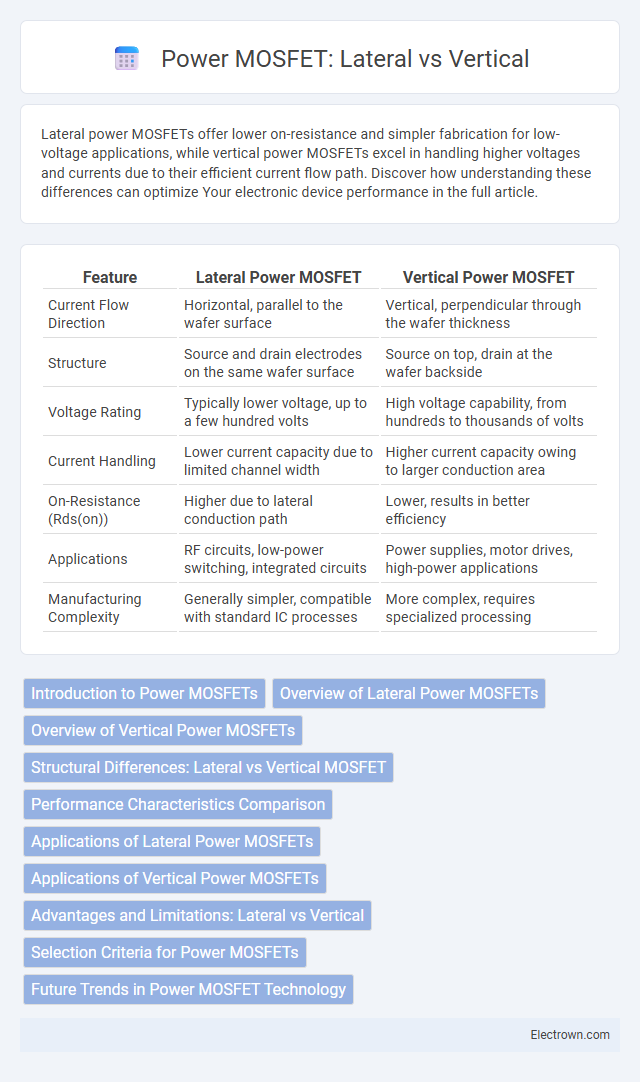Lateral power MOSFETs offer lower on-resistance and simpler fabrication for low-voltage applications, while vertical power MOSFETs excel in handling higher voltages and currents due to their efficient current flow path. Discover how understanding these differences can optimize Your electronic device performance in the full article.
Table of Comparison
| Feature | Lateral Power MOSFET | Vertical Power MOSFET |
|---|---|---|
| Current Flow Direction | Horizontal, parallel to the wafer surface | Vertical, perpendicular through the wafer thickness |
| Structure | Source and drain electrodes on the same wafer surface | Source on top, drain at the wafer backside |
| Voltage Rating | Typically lower voltage, up to a few hundred volts | High voltage capability, from hundreds to thousands of volts |
| Current Handling | Lower current capacity due to limited channel width | Higher current capacity owing to larger conduction area |
| On-Resistance (Rds(on)) | Higher due to lateral conduction path | Lower, results in better efficiency |
| Applications | RF circuits, low-power switching, integrated circuits | Power supplies, motor drives, high-power applications |
| Manufacturing Complexity | Generally simpler, compatible with standard IC processes | More complex, requires specialized processing |
Introduction to Power MOSFETs
Power MOSFETs are essential semiconductor devices utilized for efficient switching and amplification in power electronics, categorized mainly into lateral and vertical structures based on current flow direction. Lateral power MOSFETs feature current conduction parallel to the semiconductor surface, commonly used in low-voltage and integrated circuit applications due to simpler fabrication. Vertical power MOSFETs conduct current perpendicular to the substrate, enabling higher voltage and current handling capabilities ideal for high-power applications like motor drives and power supplies.
Overview of Lateral Power MOSFETs
Lateral power MOSFETs feature a planar structure with current flow parallel to the substrate surface, enabling integration with low-voltage CMOS processes. These devices exhibit lower breakdown voltages and higher on-resistances compared to vertical MOSFETs, making them suitable for applications requiring fast switching and low voltage operation. Commonly used in analog and RF circuits, lateral MOSFETs offer compact layout and ease of integration in mixed-signal ICs.
Overview of Vertical Power MOSFETs
Vertical power MOSFETs feature a current flow perpendicular to the semiconductor surface, enabling higher current capacity and better thermal performance compared to lateral MOSFETs. Their design allows for smaller on-resistance and superior efficiency in high-power applications such as power supplies and motor drives. Optimizing your circuits with vertical power MOSFETs ensures improved conduction and switching characteristics for demanding electronic devices.
Structural Differences: Lateral vs Vertical MOSFET
Lateral MOSFETs feature a planar structure where the current flows parallel to the semiconductor surface, resulting in shorter channel lengths and easier integration with CMOS technology. Vertical MOSFETs are designed with current flowing perpendicular to the surface, allowing for higher current densities and improved thermal performance due to their deeper conduction paths. The vertical design enables better scalability for high-power applications, while lateral structures are preferred for low-voltage and high-frequency circuits.
Performance Characteristics Comparison
Lateral power MOSFETs offer lower on-resistance and faster switching speeds, making them ideal for low-voltage applications requiring efficient thermal management and minimal conduction losses. Vertical power MOSFETs excel in high-voltage environments due to their superior current handling capability and higher breakdown voltage, attributed to their multi-layered silicon construction. Performance optimization of these devices depends on application-specific needs with lateral MOSFETs favored in compact, high-frequency circuits and vertical MOSFETs preferred for power-intensive industrial systems.
Applications of Lateral Power MOSFETs
Lateral power MOSFETs are widely used in low-voltage applications such as power management circuits, audio amplifiers, and analog switches due to their excellent switching speed and low on-resistance. Their planar structure makes them ideal for integration into CMOS processes, enabling efficient control in battery-operated devices and portable electronics. You benefit from their compact design and enhanced reliability in applications requiring fast switching and precise control at lower voltage levels.
Applications of Vertical Power MOSFETs
Vertical Power MOSFETs are widely used in high-current applications such as power supply units, motor controllers, and automotive electronics due to their low on-resistance and superior current handling capabilities. Their vertical structure enables efficient heat dissipation, making them ideal for switching power devices in DC-DC converters and battery management systems. Power amplifiers and industrial automation equipment also benefit from vertical MOSFETs for reliable high-frequency switching performance.
Advantages and Limitations: Lateral vs Vertical
Lateral power MOSFETs offer advantages such as easier integration with CMOS technology, low gate charge, and superior high-frequency performance, making them suitable for RF and low-voltage applications, but they suffer from higher on-resistance and lower voltage handling capacity compared to vertical MOSFETs. Vertical power MOSFETs provide superior current handling, lower on-resistance, and higher breakdown voltage due to their vertical current flow design, making them ideal for high-power and high-voltage applications, though they typically have larger chip sizes and slower switching speeds. Your choice between lateral and vertical MOSFETs depends on the trade-off between integration complexity, switching frequency, and power requirements for your specific application.
Selection Criteria for Power MOSFETs
When selecting power MOSFETs, consider lateral MOSFETs for low-voltage, high-frequency applications due to their faster switching speeds and ease of integration in ICs. Vertical MOSFETs excel in high-voltage and high-current scenarios, offering lower on-resistance and better thermal performance, which suits power management and industrial uses. Your choice depends on the required voltage rating, current capacity, switching frequency, and thermal efficiency to optimize overall device performance.
Future Trends in Power MOSFET Technology
Future trends in power MOSFET technology emphasize enhanced efficiency and miniaturization, with vertical MOSFETs leading due to their superior current handling and lower on-resistance compared to lateral MOSFETs. Innovations like wide bandgap materials (SiC and GaN) are expanding the operational limits of vertical MOSFETs, offering higher voltage ratings and faster switching speeds. Your choice of MOSFET will increasingly depend on balancing performance requirements with thermal management and integration density in advanced electronics.
Lateral vs vertical power MOSFET Infographic

 electrown.com
electrown.com